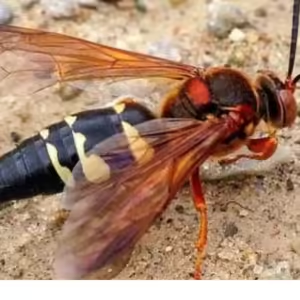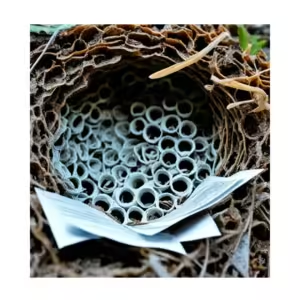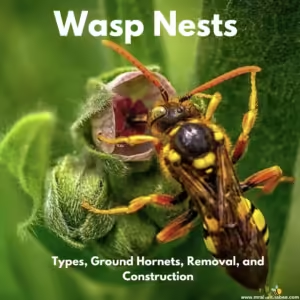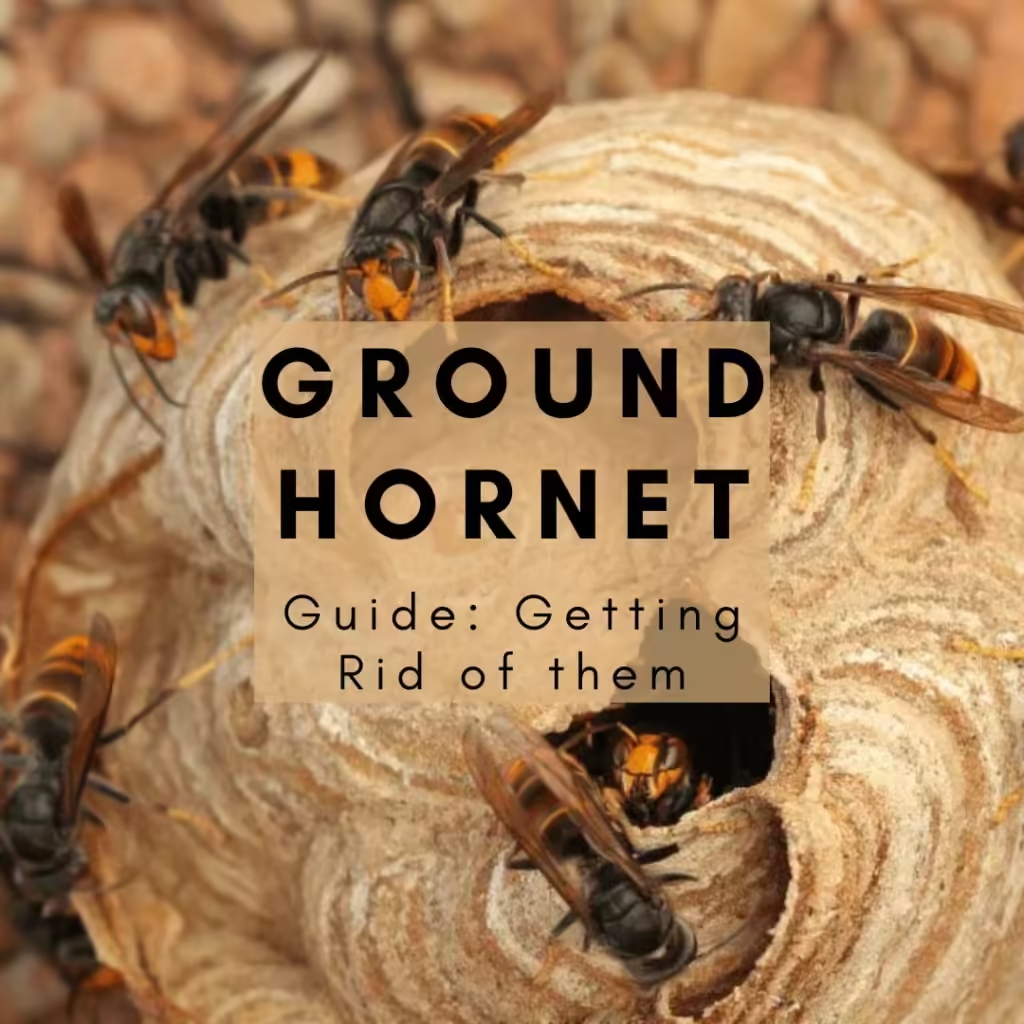Scientifically known as cicada killer wasps or ground wasps. Ground hornets are large stinging insects that typically nest underground. They often create burrows and dining holes in lawns, gardens, or fields, preferring sandy or loose soil. Generally less aggressive than many other wasp species, they tend to avoid humans despite their intimidating size. These wasps play a crucial role in the ecosystem by controlling populations, particularly cicadas, which they paralyze and use as food for their larvae.
While ground-nesting wasps are important for the environment, they are usually not aggressive. However, they can sting if they feel threatened or if someone approaches their colony. Understanding their behavior and knowing the safest ways to manage them is essential for keeping your yard and family safe.

Identification of Ground Hornets
Ground hornets take control of distinct characteristics that make them easily identifiable. These pests usually measure up to two inches in length and have black bodies adorned with yellow markings, resembling those of their close relative, the yellow jacket. Unlike other stinging insects, these wasps tend to be more solitary, similar to solitary bees. Commonly larger than other wasp species, they feature dark black and yellow or white markings. They are prominent species including the Eastern cicada killer and the European hornet, both of which exhibit these unique colors.

Behavior and Ecology Of Ground Hornets
Signs of Ground Hornet Infestation
Visible Holes in the Lawn or Patio
Dirt Piles as Nest Indicators
Nesting Habits in Walls
Understanding the Population Dynamics
Ground digger wasps don’t show up all at once. In their first year in your garden, you might only see a few of them, and they may not be very noticeable. However, their population can increase quickly. Because digger wasps don’t reuse the same nest, their tunnels and burrows can disturb the soil in your yard, resulting in unsightly patches.
Long-Term Impacts on Your Yard
Safety Precautions
Wear Protective Clothing
Opt for long-sleeved shirts and long pants, to cover your skin and minimize the risk of stings. Sturdy gloves are essential for protecting your hands while working near their nesting areas, and closed-toe shoes or boots will help shield your feet from potential stings.
Choose the right time to work
Scheduling your activities for early morning or late evening when ground hornets are less active. It’s best to avoid the warmest parts of the day, as this is when they are more likely to be out and about.
Stay aware of your surroundings
By looking for visible signs of ground hornet nests, like dirt mounds or holes in the ground. If you do find a nest, keep a safe distance and watch their behavior to better understand them without getting too close.
Use Caution When Disturbing the Area
When working in the area, use gentle movements to avoid startling the hornets. Quick motions can provoke them, so try to keep noise levels down—avoid shouting or using loud power tools, as these can agitate the hornets.
Have an Emergency Plan
It’s also important to have an emergency plan. Familiarize yourself with first aid procedures in case of a sting, and keep antihistamines or an epinephrine auto-injector handy if you or anyone nearby has a wasp allergy. If you’re uncertain about handling a nest or if the infestation is serious, it’s wise to contact a pest control professional for safe removal.
By following these safety measures, you can significantly lower the chances of encountering ground hornets and create a safer working environment.
Effective Methods for Getting Rid of Ground Hornets
DIY Approaches:
- Nighttime Treatments: Ground hornets are less active at night, making it safer to approach their nests. Use a flashlight with a red filter, as hornets can’t see red light.
- Insecticidal Dust or Sprays: Apply insecticidal dust specifically formulated for wasps directly into the nest entrance. Always follow product instructions carefully.
- Natural Remedies: A soap and water solution can be an effective natural method. Pour the mixture directly into the nest entrance at night.
Professional Control:
-
If DIY methods fail or you feel uncomfortable tackling the situation, hiring a pest control expert is a smart choice. Professional exterminators have the experience and specialized equipment needed to safely and effectively remove hornet nests.
- Pest control professionals are trained to evaluate the severity of the infestation and determine the best course of action. They can accurately identify the specific species of hornet, which is essential for choosing the right treatment methods.
- These experts have access to advanced tools and insecticides that are often more effective than what you can find over the counter.
-
One of the key benefits of hiring a professional is safety. Ground hornets can become aggressive if they feel threatened, and attempting to handle them without the right knowledge or equipment can lead to painful stings or allergic reactions. Professionals know how to approach nests carefully, minimizing the risk of provoking the hornets.
-
Additionally, pest control services typically offer follow-up treatments and advice on preventive measures to help you avoid future infestations. They can provide guidance on maintaining your yard to discourage hornets from nesting nearby, such as removing food sources and sealing potential nesting sites.
-
Overall, if you’re unsure about managing the situation or if the infestation seems extensive, reaching out to a pest control expert can save you time, ensure your safety, and effectively resolve the problem.
Preventative Measures
Since ground hornets prefer nesting in loose soil, maintaining good lawn care is crucial. Regularly address any areas of dead grass or bare spots to keep your yard healthy. Ensuring that the soil stays adequately moist can prevent it from becoming too loose, making it less inviting for these ground wasps.
Ground hornets typically favor sunny locations for their nests, so planting shade-providing vegetation can be an effective strategy to deter them. Be mindful that if the soil structure remains suitable, ground hornets are likely to return year after year. If you notice they keep coming back, it may be time to consult pest management professionals.
A pest management expert possesses the knowledge, equipment, and experience needed to effectively tackle ground hornet infestations. Locating and treating nests can be difficult, especially if many are hidden in your area. These professionals can accurately identify the problem and suggest the best solutions. They can also manage other stinging insect nests, such as those of yellowjackets, paper wasps, and bumble bees, should they become a nuisance.
Conclusion
Understanding ground hornets and how to safely manage them is essential for a safe and comfortable outdoor environment. If ground hornets are a concern in your yard, address the issue quickly and take precautions to handle them effectively.
FAQs
1. What are ground hornets?
Ground hornets are wasps that build nests in the soil and often have black and yellow or white markings.
2. Are ground hornets aggressive?
They are generally non-aggressive but will become defensive if their nest is disturbed.
3. When are ground hornets most active?
They are most active from late spring to early fall.
4. How do I identify a ground hornet nest?
Look for small holes in the ground with loose dirt around the entrance and increased wasp activity.
5. Is it safe to remove a hornet nest myself?
It can be done with care, but it’s essential to take safety precautions, such as working at night and wearing protective gear.
6. What natural methods can help get rid of ground hornets?
A soap and water solution poured into the nest can be effective for small infestations.
7. Should I hire a professional for large infestations?
Yes, professional pest control is recommended for larger nests or if you’re uncomfortable handling it yourself.
8. How can I prevent ground hornets from nesting in my yard?
Keep your yard clean, fill any ground holes, and eliminate food sources that might attract them.
9. What is the best time to remove a ground hornet nest?
Nighttime is ideal since hornets are less active.
10. Do ground hornets provide any ecological benefits?
Yes, they help control pest populations and can also aid in pollination.

Thank you for reading, for more interesting articles visit our homepage.
Visit the link to learn more about Wasp and its types.



